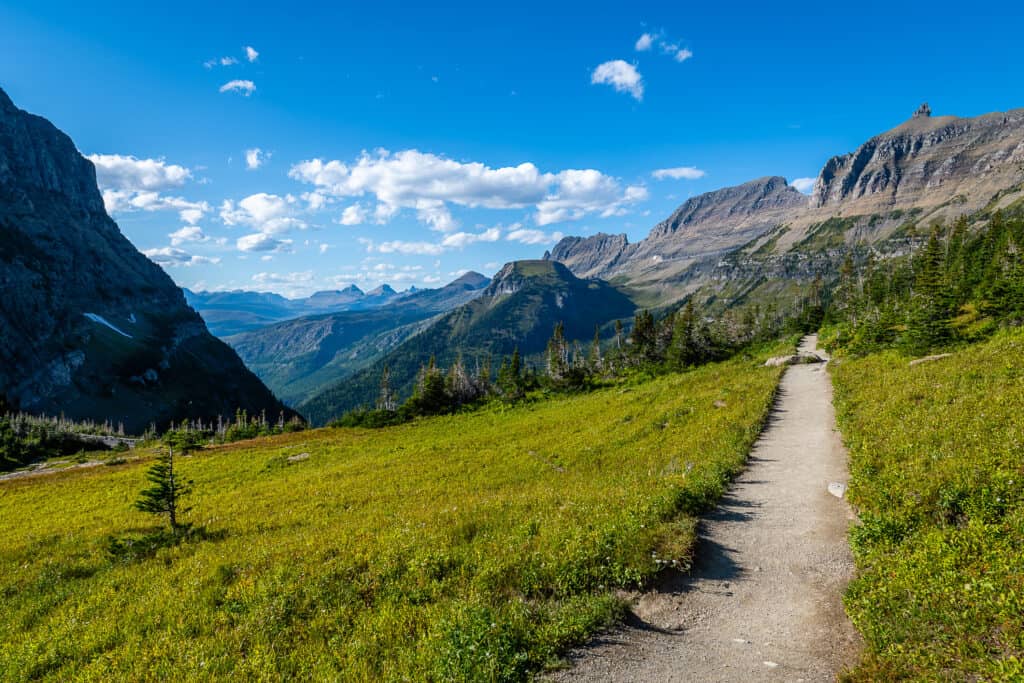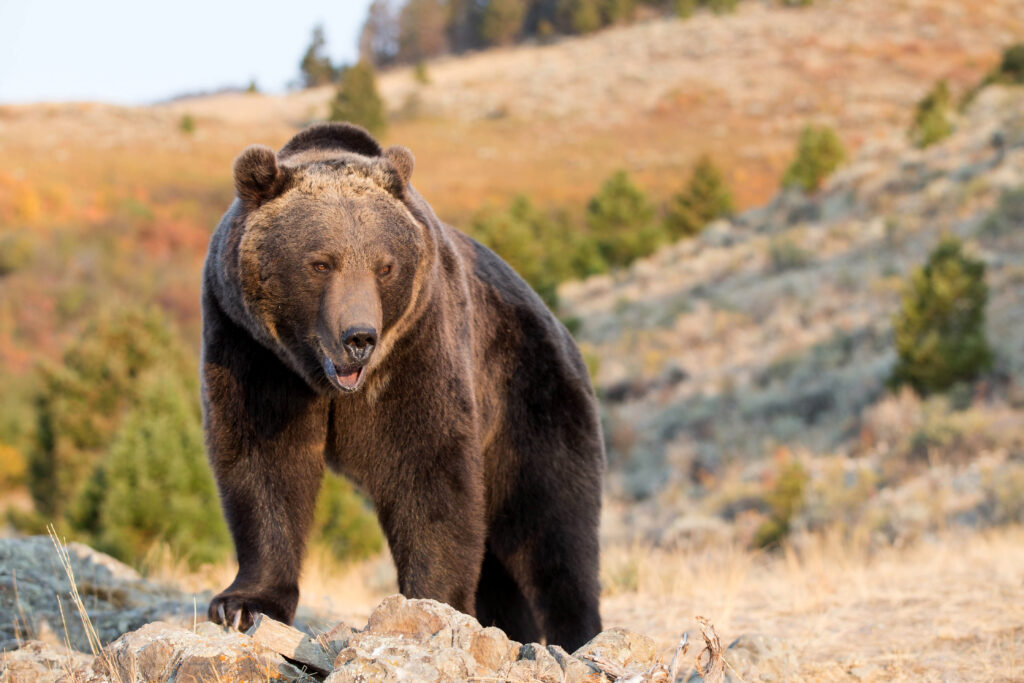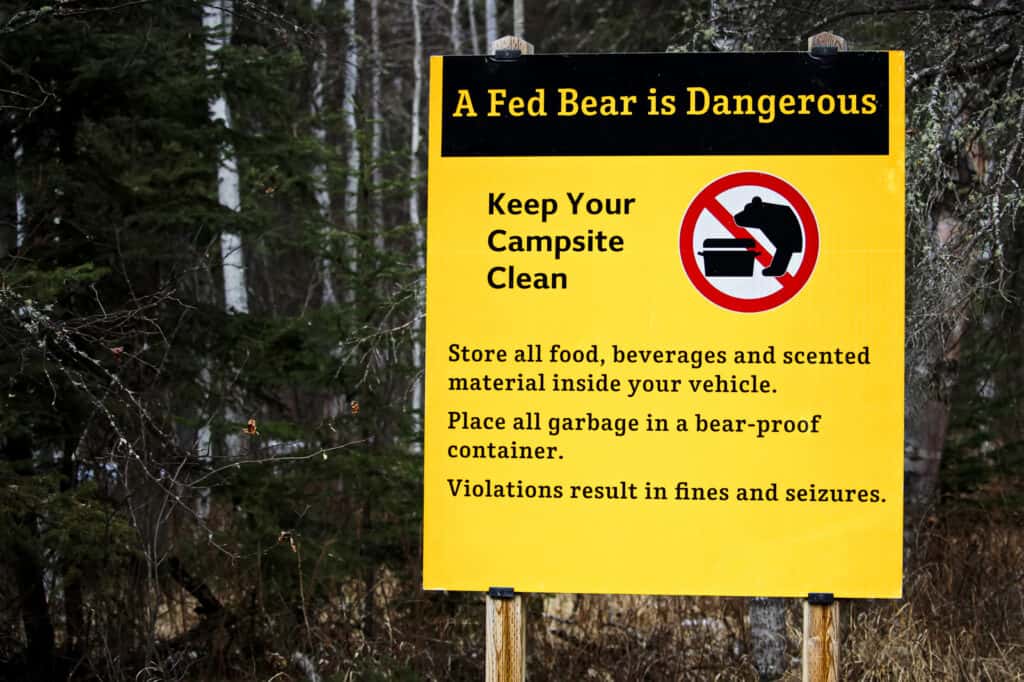Traveling to Glacier National Park is a bucket list item for many people. It’s inarguably one of the most beautiful places in the United States, and the chance to hike and camp through mountain ranges, pristine wilderness, and glacial lakes is one that’s hard to pass up.
Still, there’s another aspect of the trip that weighs heavy on every traveler’s mind — grizzly bears.
A few hundred grizzlies live in the park. When you set foot on any trail there, you are in bear country. Trails often venture deep into forests, high upon cliffsides and mountaintops, and there’s always a chance that there are grizzly bears nearby.
If you’re out in the wilderness and you encounter a bear, it’s important that you know what to do. A brush with a wild grizzly bear can be one of the most exciting and memorable experiences of your life, but it could also take a serious turn for the worse.
Before talking a little bit about how to handle an encounter with a grizzly, let’s look at how often they attack and explore your odds of getting into a dangerous situation at Glacier National Park.
Fatal Attacks in Glacier National Park
If you’re sitting in the passenger seat on a road trip right now, eagerly watching Glacier’s mountains rise up in the distance, odds are that you’re casually googling grizzly attacks to put yourself at ease.
If that’s you, you’re in luck. Sort of. There have only been 10 fatal bear encounters in the park since 1967.
A couple of million visitors enter the park every single year. Not all of those people hike the trails, so let’s just say that even 1 million people hit the trails in Glacier each year. 1967 was 55 years ago, so that makes 55 million hikers. That puts your odds of getting into an attack at 0.00000018.

A couple of million visitors enter Glacier National Park every single year.
©iStock.com/Chris LaBasco
What Was The Most Famous Grizzly Bear Attack?
In Katmai National Park, Alaska, on October 5, 2003, Treadwell and his girlfriend, Amie Huguenard, tragically lost their lives during an encounter with a 28-year-old male bear. Subsequently, it was discovered that the bear had ingested almost the entirety of their remains and clothing.
Treadwell and Huguenard had originally planned to leave the park, but after a disagreement over airline ticket prices, they decided to extend their stay. Treadwell was particularly concerned about a specific female brown bear and preferred being in nature with bears over city life.
The bears he had been familiar with during the summer were hibernating, and unfamiliar bears were moving into the area.
Some of his final footage showed a bear he felt uncomfortable around, and it’s speculated that this bear may have been involved in their tragic demise.
What That Does & Does Not Mean
First things first, that means you have a very, very small chance of being killed by a bear in the park. The nightmarish situations you’re conjuring up, then, are not likely to manifest in reality. Pfew! You can breathe a sigh of relief.
That also means that bears generally aren’t seeking out humans as a prey source. Again, pfew! Like most animals, they will keep a healthy distance from you under normal circumstances. That does not mean, on the other hand, that you’re perfectly safe. People don’t get killed by bears in the park very often because there is a clear protocol for handling encounters with grizzlies and managing yourself in bear country in general.
If you’re not smart about the way you handle yourself in the park, you increase your odds of negative encounters with bears. The fear and respect we have for bears exist for very good reasons. If we don’t trust that instinct to be cautious in bear country, we put ourselves at risk.
Let’s look at a few examples of genuine bear attacks and see the factors that might have contributed to them occurring in the first place.

There have only been 10 fatal bear encounters in Glacier National Park since 1967.
©Dennis W Donohue/Shutterstock.com
“The Night of The Grizzlies”
The area was named a National Park in 1910. From 1910 until 1967, there were no maulings. 57 years of peace from bears led people to believe that they were not really threats to humans. Sure, there was an awareness that bear attacks were possible, but nobody thought they were anything to worry about.
People would feed and watch bears from close range. Visitors would do things like gather around and watch grizzly bears feed from park dumpsters and campsites. Then, on the night of August 12, 1967, two young women were mauled and killed by two different bears in different areas of the park. That’s two distinct maulings on the same night at around the same time.
The odds of this happening seem infinitesimal, but the reality was that visitor behavior had conditioned bears to associate humans with food. The likelihood of it happening all at once like that is still incredible, however. The event is referred to as “The Night of The Grizzlies.” It served as a wake-up call for park management as well as every visitor who would set foot in the park from that point on.
What’s It Like at Glacier Now?
Now, the park is managed with extreme respect for bears. Bears are ever-present in the minds and actions of visitors and staff. It’s important to be mindful of the food you have and the way you manage it. Signs and indications about food and camping put in place by park management are extremely important.
If you’re camping with a friend who likes to bend the rules and do things their own way, make sure you tell them what’s at stake. Those signs are truly there for your safety and the safety of the people around you. Campsites are strategically placed, and the staff goes to great lengths to monitor bear activity and keep it away from campers.
Any encounters or attacks that do happen typically occur out on the trails. Further, they usually happen when a person is walking alone, jogging, or biking. The nice thing is, most trails are well-populated during the busy summer months. That might not be the case if you’re going in early spring or late fall, however. If you’re hiking at less-busy times, do your best to get a group of a few people together. Bears are less likely to engage with larger groups than they are individuals.
So, know that Glacier has inherent risks, but it is well managed and safe for visitors. It’s wise to fear bears to some extent, but do your best to learn the rules of the park and prepare yourself so that you can enjoy the experience of possibly seeing a bear from a distance.
Non-Fatal Attacks Are More Frequent
Just because people aren’t getting killed doesn’t mean that attacks aren’t happening. There are frequent grizzly bear attacks across North America each year, many of them happen along the Rocky Mountain range, of which Glacier National Park is a part.
In October of 2022, a man and woman were hunting when a 700-pound male bear exploded from the brush and trampled the man. He survived, but only narrowly. That bear didn’t have a history of attacks, either. For whatever reason, it simply attacked the man.
In September 2022, a few hikers were chased by a grizzly bear in Glacier. They were fine, but the bear was aggressive until it left them alone.

In September 2022, a few hikers were chased by a grizzly bear in Glacier National Park.
©Kelp Grizzly Photography/Shutterstock.com
How to Reduce Your Risk of Bear Attacks
The threat of a bear attack drops greatly when you know how to handle yourself in grizzly country. Let’s look at some of the simple things you can do to reduce your risk of having a negative encounter with a bear in Glacier National Park.
1. Talk to Park Rangers
If you’re at all nervous about how to handle the bears in Glacier, talk with a ranger. These are people who not only know what they’re talking about but also see grizzly bears almost every day.
Rangers are the ones who show up when bears get too close to humans in the park. They’re so confident in their ability to approach and de-escalate situations with grizzly bears that they get paid to do it for a living. So, these are the people that know best. Ask rangers what to do if you see a bear, what to do if the bear charges you, and how to handle yourself if the bear actually does become aggressive.
Bears tend to perform what’s called a “bluff charge.” As the name suggests, this is a big gesture from the bear that doesn’t result in an attack. They just lunge forward at you to test the situation. That’s something a park ranger will discuss with you. We promise you’ll feel a great deal more confident after talking with one of them.
2. Make Noise on Trails
If you’re on trails that aren’t busy with foot traffic, you should be making noise. Clap your hands on a regular basis, shout out different things, sing songs, or do whatever you want to make noise.
Some people strap “bear bells” to their boots or backpacks. These are like little jingle bells that make a sound every time you step. It’s worth noting that it’s not entirely clear whether bear bells help or hurt you when it comes to bear encounters. Studies have shown that bears might be more likely to stand their ground if you’re wearing bells. So, the best bet is to use your voice and your body to make noise and to make that noise often.
The goal is to make yourself known to whatever is out there before you walk up and startle it. If a bear knows you’re there, it’s much more likely to move away or simply watch as you pass by. If you startle a bear, you open up a can of worms that could involve an attack. So, don’t be embarrassed to get a little loud.

If you’re on trails that aren’t busy with foot traffic, you should be making noise to reduce your risk of a bear encounter.
©iStock.com/Matthew James Ferguson
3. Be Mindful of Food
We’re talking very, very mindful. Bears can smell 2,000 to 3,000 times better than we can. That’s an exponentially more sophisticated experience than the one that we have with smells. It means bears can smell what’s in your backpack, what’s in your pocket, or what’s on your fingers. They can probably even smell it well before you’re in their area, too.
If you smelled some tasty chocolate or (god forbid) meat in your neighborhood, wouldn’t you meander over to see where it was? It’s a rock-and-a-hard-place kind of situation for hikers, though. You can’t reasonably hike 10 miles through mountainous terrain without food and water.
So, your job is to bring some kind of smell-proof container that fits in your pack. Put all of your wrappers in that container. Don’t bring more than you have to, and make sure you clean up after yourself.
When it comes to the campsite, the same rules apply. You’ll also note that the campfire pits are typically separated from the tent spots at Glacier. This is because you shouldn’t cook right next to the spot where you’re sleeping. Here’s a more in-depth exploration of handling food in bear country.

You can reduce your risk of a bear attack by following proper food-handling procedures when in bear country.
©iStock.com/Akchamczuk
4. Have Bear Spray
Some people will tell you that a gun is the best defense against a grizzly bear. This isn’t the case. These animals are massive and resilient. You are unlikely to eliminate the threat with your first one or two shots. Obviously, if you are in a life-or-death situation, you only have so many options, so a gun could be useful in those moments. The most likely scenario involving a gun, though, is that you shoot the bear and it simply gets angrier at you. In that instance, there would be very little that you could do to defend yourself further.
Bear spray, on the other hand, is a proven bear deterrent. It is extremely powerful, it shoots at a range of 20-30 feet, and it’s a much safer alternative to a gun. It’s smart to have a couple of canisters on your person in case you drop or lose one on your trip. So, even if you know nothing else, simply having bear spray will improve your odds of passing through bear country unscathed.
Also, make sure that your bear spray is easily accessible. Don’t zip it into your backpack or tuck it away in a pocket. You should be able to grab your bear spray without taking off your pack or shifting all that much. Think of it like a gun in a holster. If you need it, you need it fast so there’s no point in keeping it in your backpack. Try to hook it onto your belt or to the side of your pack if those are options.
5. Know What to Do When You See Bears
Doing all of the things above won’t eliminate the chance of seeing bears. In fact, there’s always a chance that you’ll see a grizzly bear at some point in Glacier. It’s not uncommon for visitors to see numerous grizzlies throughout their trip. If you encounter a bear on a trail, do not run. Stop, take a breath, and gather yourself.
Then, identify the species of bear (grizzlies have humps)
If It’s a Grizzly,
- Grab your bear spray slowly
- Don’t make eye contact with the bear
- Back away very slowly without turning around
- Talk to the bear in a slow and calm voice
- If the bear backs away, you should keep backing away as well
- If the bear bluff charges, use your bear spray
The odds are that any encounter with a bear will be over long before a bluff charge occurs. Bears are largely very peaceful, even toward strange humans. If the bear bluff charges, you use your bear spray, and the bear is not deterred, this is the time to play dead.
The bear may become aggressive, and it’s your job to do what you can to protect yourself. That does not mean challenging the bear in any way. No human being can physically challenge a grizzly bear and win.
Instead,
- lay flat on your stomach with your elbows spread so you’re harder to flip over (this allows your back to protect your vital organs)
- Cover your neck with your hands to shield your spine
- Remain as calm as you can
At that point, all you can do is wait.
But think back to the first section of this article when we discussed your odds of having a fatal experience with a grizzly bear in Glacier National Park. They are extremely low. Plus, the right knowledge and preparation for your time in Glacier will give you the confidence to avoid costly mistakes in bear country, and this drops your chances of negative encounters with bears even further.
Equipped with the knowledge above and a useful conversation with a park ranger, you can expect your trip to Glacier to be nothing short of amazing and unforgettable.
The photo featured at the top of this post is © Scott E Read/Shutterstock.com
Sources
- National Parks Service, Available here: https://www.nps.gov/glac/learn/nature/bears.htm
- Hiking Glacier, Available here: http://www.hikinginglacier.com/glacier-national-park-bears.htm
- Smithsonian Mag, Available here: https://www.smithsonianmag.com/history/deadly-grizzly-bear-attacks-changed-national-park-service-forever-180964462/
- Hiking and Fishing, Available here: https://hikingandfishing.com/bears-sense-of-smell/
Thank you for reading! Have some feedback for us? Contact the AZ Animals editorial team.







